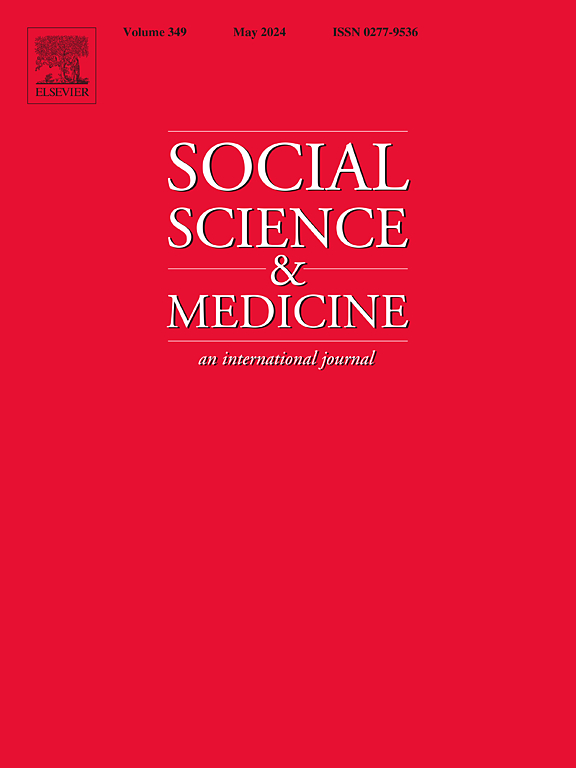Exploring the relationship between depressive symptoms, allostatic load, and income inequality in US adults aged 20 and older
IF 5
2区 医学
Q1 PUBLIC, ENVIRONMENTAL & OCCUPATIONAL HEALTH
引用次数: 0
Abstract
Background
Allostatic load, reflecting the cumulative physiological impact of persistent stress on the body, has been recognized as a correlate of physical health outcomes. Despite well-documented associations between allostatic load and physical health, there is limited understanding of its connections to depressive symptoms. In particular, less is known about how socioeconomic status (SES) may moderate this relationship, despite theoretical rationale for such an interaction.
Objective
This study utilizes large diverse nationally representative data from the National Health and Nutrition Examination Survey (NHANES) to investigate the association between allostatic load, depression, and poverty-to-income-ratio (PIR).
Methods
We conducted a cross-sectional secondary analysis of NHANES data (2005–2018) for adults (defined as 20-year or older), exploring the link between allostatic load (AL), measured through various physiological markers, and depressive symptoms assessed with the Patient Health Questionnaire (PHQ). The analysis included weighted binomial regressions to report Incidence Rate Ratio (IRR) that controlled socioeconomic status and health-related behaviors.
Results
After controlling socioeconomic status and health-related behaviors, our findings demonstrate a significant association between high allostatic load and increased depressive symptoms (IRR: 1.22, CI = 1.13–1.32). This suggests that the physiological toll of chronic stress, as captured by allostatic load, is independently linked to elevated levels of depressive symptoms in a nationally representative sample.
Conclusion
This study contributes to the understanding of the association between physiological stress, allostatic load and PIR on a national scale. It underscores the importance of recognizing allostatic load as a potential target for interventions aimed at preventing or mitigating depressive symptoms in the population.
探讨20岁及以上美国成年人抑郁症状、适应负荷和收入不平等之间的关系。
背景:适应负荷反映了持续应激对身体的累积生理影响,已被认为与身体健康结果相关。尽管有充分的文献证明适应负荷与身体健康之间存在关联,但对其与抑郁症状之间的联系了解有限。特别是,社会经济地位(SES)如何调节这种关系,尽管这种相互作用的理论基础知之甚少。目的:本研究利用来自全国健康与营养调查(NHANES)的大量不同的具有全国代表性的数据来调查适应负荷、抑郁和贫困收入比(PIR)之间的关系。方法:我们对成人(定义为20岁或以上)的NHANES数据(2005-2018)进行了横断面二次分析,探索通过各种生理标志物测量的适应负荷(AL)与患者健康问卷(PHQ)评估的抑郁症状之间的联系。分析包括加权二项回归来报告控制社会经济地位和健康相关行为的发病率比(IRR)。结果:在控制社会经济地位和健康相关行为后,我们的研究结果表明,高适应负荷与抑郁症状增加之间存在显著关联(IRR: 1.22, CI = 1.13-1.32)。这表明,慢性应激的生理代价,如适应负荷所捕获的,与全国代表性样本中抑郁症状水平升高独立相关。结论:本研究有助于在全国范围内了解生理应激、适应负荷与PIR之间的关系。它强调了认识到适应负荷作为旨在预防或减轻人群抑郁症状的干预措施的潜在目标的重要性。
本文章由计算机程序翻译,如有差异,请以英文原文为准。
求助全文
约1分钟内获得全文
求助全文
来源期刊

Social Science & Medicine
PUBLIC, ENVIRONMENTAL & OCCUPATIONAL HEALTH-
CiteScore
9.10
自引率
5.60%
发文量
762
审稿时长
38 days
期刊介绍:
Social Science & Medicine provides an international and interdisciplinary forum for the dissemination of social science research on health. We publish original research articles (both empirical and theoretical), reviews, position papers and commentaries on health issues, to inform current research, policy and practice in all areas of common interest to social scientists, health practitioners, and policy makers. The journal publishes material relevant to any aspect of health from a wide range of social science disciplines (anthropology, economics, epidemiology, geography, policy, psychology, and sociology), and material relevant to the social sciences from any of the professions concerned with physical and mental health, health care, clinical practice, and health policy and organization. We encourage material which is of general interest to an international readership.
 求助内容:
求助内容: 应助结果提醒方式:
应助结果提醒方式:


